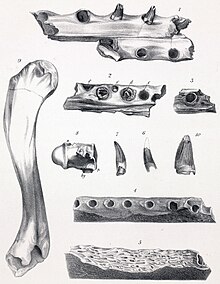| Dollosuchus Temporal range:
| |
|---|---|

| |
| Fossils referred to Gavialis dixoni (now Dollosuchus dixoni) by Richard Owen | |
| Scientific classification | |
| Domain: | Eukaryota |
| Kingdom: | Animalia |
| Phylum: | Chordata |
| Class: | Reptilia |
| Clade: | Archosauromorpha |
| Clade: | Archosauriformes |
| Order: | Crocodilia |
| Family: | Gavialidae |
| Subfamily: | Tomistominae |
| Genus: | †Dollosuchus Swinton, 1937 vide Owen, 1850 |
| Type species | |
| †Dollosuchus dixoni Owen, 1850
| |
| Synonyms | |
| |
Dollosuchus (meaning "Louis Dollo's crocodile") is an extinct monospecific genus of tomistomine crocodilian originally named as a species of Gavialis.[1] It is a basal form possibly related to Kentisuchus, according to several phylogenetic analyses that have been conducted in recent years,[2][3][4] and is the oldest known tomistomine to date. Fossils have been found from Belgium and the United Kingdom.[5] It had large supratemporal fenestrae in relation to its orbits, similar to Kentisuchus and Thecachampsa.[6]
Dollosuchus was originally described on the basis of numerous mandibular fragments found from the Early to Middle Eocene Bracklesham Beds Formation in the United Kingdom. The material cannot be distinguished from other related longirostrine, or long-snouted, crocodilians. A nearly complete skeleton from Belgium (IRScNB 482) discovered in 1915 and described by Swinton in 1937,[5] and referred to Dollosuchus, formed the basis of the new taxon Dollosuchoides densmorei.[4] The holotype, BMNH 26125 and BMNH 26126, is now on display at the World of Kina museum in Ghent, Belgium.
- ^ Owen, R. (1849). A History of British Fossil Reptiles, Part I. 1-328
- ^ Jouve, S. (2004). Etude des crocodyliformes fini Crétace−Paléogène du Bassin de Oulad Abdoun (Maroc) et comparaison avec les faunes africaines contemporaines: systématique, phylogénie et paléobiogéographie. Ph.D. thesis. 652 pp. Muséum National d’Histoire Naturelle de Paris, Paris.
- ^ Delfino, M.; Piras, P.; Smith, T. (2005). "Anatomy and phylogeny of the gavialoid crocodylian Eosuchus lerichei from the Paleocene of Europe". Acta Palaeontologica Polonica. 50: 565–580.
- ^ a b Brochu, C. A. (2007). "Systematics and taxonomy of Eocene tomistomine crocodylians from Britain and Northern Europe". Palaeontology. 50 (4): 917–928. Bibcode:2007Palgy..50..917B. doi:10.1111/j.1475-4983.2007.00679.x.
- ^ a b Swinton, W. E. (1937). The Crocodile of Maransart (Dollosuchus dixoni [Owen]). Mémoire 80: 3-46
- ^ Piras, P.; Delfino, M.; Del Favero, L.; Kotsakis, T. (2007). "Phylogenetic position of the crocodylian Megadontosuchus arduini and tomistomine palaeobiogeography". Acta Palaeontologica Polonica. 52 (2): 315–328.